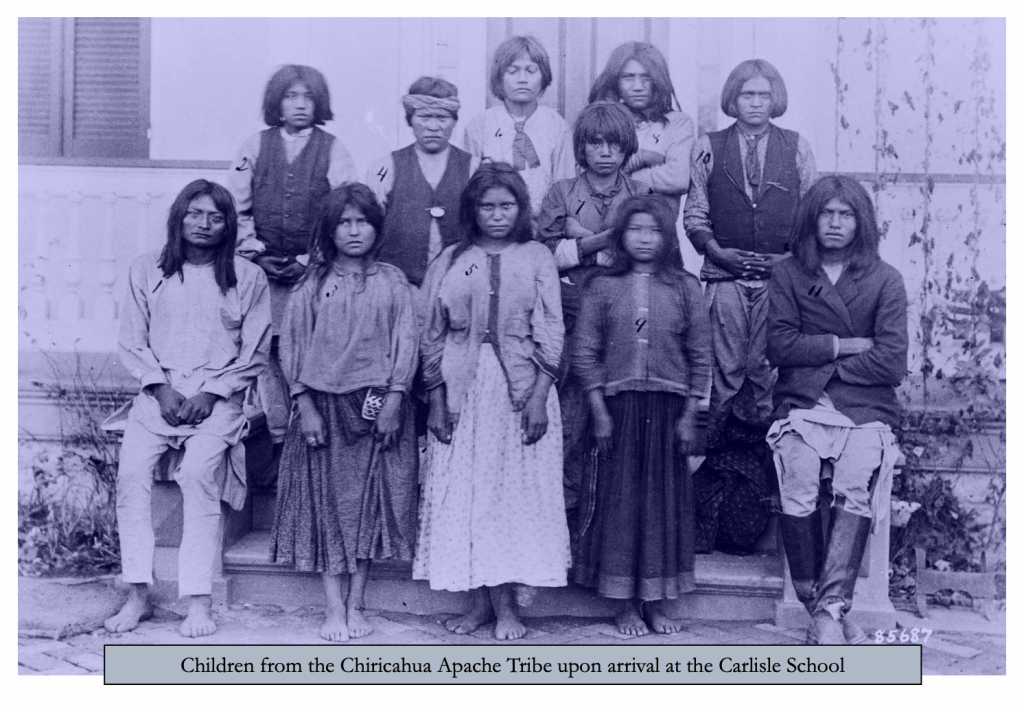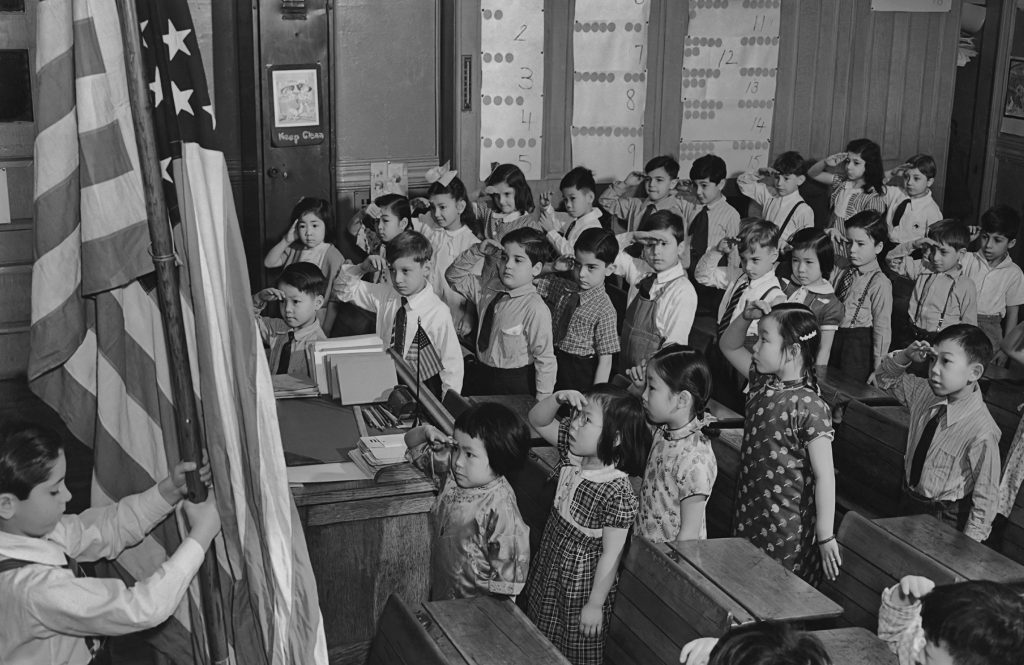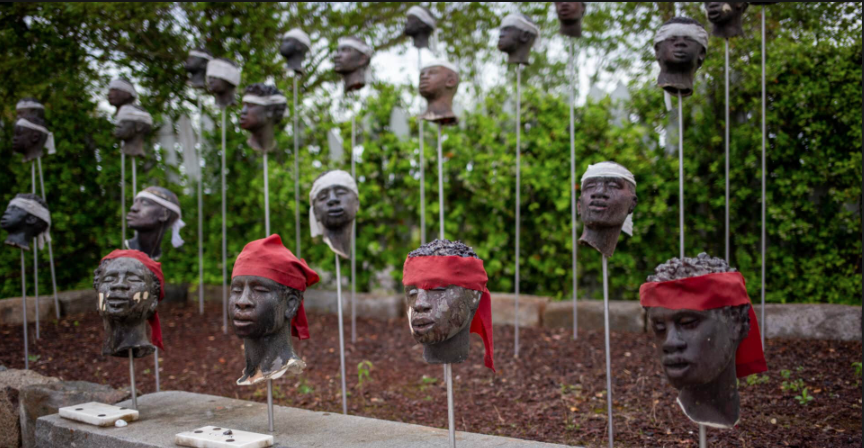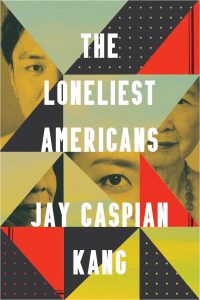Assimilation
Definition
There are many definitions for assimilation, and the word itself has many connotations and denotations. In most dictionaries, assimilation is the absorption of groups by making groups similar. For instance, in the Merriam-Webster dictionary, assimilation is broken into two definitions. The first definition is the biological definition which is “to take in and utilize as nourishment: to absorb into the system.” [1] The second definition is “to absorb into the cultural tradition of a population or group”, and the third definition is to make something similar or likened. While in some dictionaries, assimilation has the connotation of indifference there are other contexts in which assimilation is positive. Assimilation in child developmental psychology was proposed by Jean Piaget as a cognitive process children undertake as they experience the world around them. [2] As children develop, they process the world around them through the information they already know and come to a greater understanding of it. Therefore, assimilation in psychology is essential for child development. While dictionaries present the process of assimilation with indifference, in society assimilation is not an indifferent process, but a political, social, and violent process.
The Twilight Zone, a science fiction horror show, presents an episode on assimilation named The Eye of the Beholder where a woman is forced to assimilate into a society’s beauty standard. [3]
While the episode is a sci-fi horror dramatization of assimilation, similar to a real-world context, the forced assimilation of minorities into society has political and social connotations because a group’s inability to conform inhibits that society’s ability to progress. The definition of assimilation that will be illustrated throughout this page will be focusing on assimilation within a sociological, historical context. While sociology defines assimilation defines as the process whereby individuals or groups of differing ethnic heritage are absorbed into the dominant culture. [4] The definition presented on this page will define the process of assimilation throughout various points in U.S. History and the effects of assimilation on the various minorities presented throughout the page. The process of assimilation is not consistent throughout history and each group forced through this process had distinct experiences and consequences as a result of their experiences. Therefore, this page on assimilation will expand upon a few experiences that only encapsulate a fraction of the experience faced by millions of minorities from the beginning of the United States to the present day, but in expanding the definition of assimilation in this page, our goal is to remove indifference from assimilation and expand upon it as a dehumanizing process that has been an integral, fundamental part of U.S. society and culture.
Discussion – Examples of Assimilation Across Various Cultures
Indigenous Tribes in America
“Transfer the savage-born infant to the surroundings of civilization, and he will grow to possess a civilized language and habit.”
Richard Pratt: founder – the carlisle school
In 1824, the United States War Department established the first Indian office, whose goal was to eliminate the “Indian Problem.”[5] Six years later, the Indian Removal Act was passed under the authority of president Andrew Jackson. The act called for the forceful relocation of Indians to land west of the Mississippi River. [6] Before this act was established, settlers had been “attacking Indigenous religions, subsistence patterns, and landholding practices” for centuries.” [7] Following their involuntary mass exodus from the eastern U.S., Native Americans were subjected to various forced assimilation practices, perhaps the most well-known being the establishment of boarding schools. The first of such schools was founded in Carlisle, Pennsylvania in 1879. At these schools, the students were not allowed to practice their cultural traditions, they were also given new names and forced to speak English. Though these assimilation practices were extremely drastic and heavily enforced, they did not eliminate Native culture as they had hoped. These practices have damaged and had a lasting effect on these communities, but today they still practice the traditions and rituals that the government worked so hard to eradicate.

One aspect of Indigenous life that settlers fought to erase was their religious practices. As Puritans settled in the United States, they forced the Native tribes to convert to their own religion. One tribe affected by this conversion was the Massachusett people, who are native to Boston and the surrounding areas. Puritan missionary John Elliot wished to separate the Massachusett people who had converted from the “savages” who still practiced their native religion. He later established Ponkapoag, a “praying town” in which the newly Christian Indigenous peoples would live, so they could be kept separated from their “savage” counterparts while the settlers worked to erase their culture. Here, they were required to follow English customs, including their grooming styles and dress. They were also required to follow “the strict moral code of the Bible as interpreted by the Puritans” [9]. Interestingly, here the tribe was forced to assimilate into the settlers’ way of life, but they were never promised any semblance of equality to their oppressors. They were confined to a prison town with strict codes of appearance and behavior, and this had lasting effects on the Massachusett people. Today, their tribe is extremely small, and their confinement and subjugation resulted in the loss of many of their cultural traditions. They cite ritual dance and music practices, oral storytelling, and traditional medicinal practices as aspects of their culture which have survived despite all odds [9].
Asian-Americans
One of the minority groups that has been significantly impacted by assimilation is Asian Americans. Particularly, the assimilation of Asian Americans was significantly influenced by stereotypes. Asian Americans are frequently seen as “model” minorities who have successfully assimilated into American culture. That is because of the many ways in which Asian Americans have striven to fit into white American culture. This viewpoint is racialized, though. It comes to seeing Asian Americans as a social group that fully or mostly aspires to reach the same level of “whiteness” as people of European descent. According to Lisa Sun-Hee Park, an ethnic studies researcher in the US, the assimilation of Asian Americans in the US is influenced by a number of stereotypes, including but not limited to those that come from “model” minority perspectives. For instance, Sun-Hee Park contends that stereotypes of Asian Americans include high-earning, educated workers who live in desirable (white) neighborhoods. Another example of assimilation among Asian Americans can be found in the naming system. Asian Americans are often discriminated against based on their names, as, for example, when a person of non-Asian descent struggles to pronounce or remember Asian names. Therefore, Asian Americans are often expected to choose an “anglicized” name when coming to the US. [10]
Orientalism and anti-Asian prejudice also play a role in Asian American assimilation. Fueled by “Orientalist drama” [11], the assimilation of Asian Americans goes beyond just getting a higher education or a high-income job. Often, because of Orientalist paradigms, Asian Americans ascribe to assimilation models. It further reinforces the same Orientalist stereotypes that fuel the Orientalist drama. Orientalism models act as both helpful and counterproductive factors in the process of assimilation among Asian Americans. When it comes to the idea of an authoritarian, low-income Asia, it is believed that many Asian immigrants come to the US in order to be saved and pursue the American dream. Asian Americans are believed to have their own victimized stories. It supports the idea that assimilation is crucial for Asian Americans. They assimilate to be saved. However, as stated by Lisa Sun-Hee Park, this logic is “paradoxical by design.” [11] In order to fit into the role of being “insiders,” Asian Americans are forced to play the role of outsiders. It leaves out a place for Asian Americans to fully integrate into American culture.
Despite the fact that my mother’s family has resided in this country for four generations, we are perpetually viewed as foreigners, making assimilation seem impossible. That is the reason that I personally find the “American” in “Asian American” to be so important, because I am, culturally, by birth and in every other way, 100 percent American.
Amy Tieh-mei Chang for The New York Times
Contrary to popular belief, not all Asian Americans voluntarily strive to assimilate into the culture of white America. Due to anti-Asian sentiments that grew during the postwar era, many Asian Americans were long forced to assimilate. Many Japanese-Americans were compelled to relocate into internment camps during World War 2. The government was concerned that Japanese Americans might be disloyal or collaborate with their Japanese adversaries.

This has discouraged many from assimilating into American society. However, many Japanese-Americans who had been detained in camps had no choice but to assimilate into the dominant American culture after the war. Japanese-Americans were expected to integrate as quickly as possible after spending years in internment camps away from society in the hopes of avoiding discrimination.
Due to the anti-Japanese postwar sentiment, my parents were encouraged to assimilate as much as possible into the dominant (white) culture.
Elaine Ikeda, The New York Times
African-Americans
Since 1619, slavery was the foundation of the United States and was a crucial aspect of American culture and economy that seeped into all aspects of the United States, from its legislation to its social structures. African-Americans were forced to assimilate into their roles within the culture of slavery. Eugene Genovese describes how masters “must fulfill his duties to his slaves; they will, of course, do their duty to him and respond positively to his demands, so that his kindness and even indulgence may become natural gestures.” [12] According to Genovese, slave culture in the United States was paternalistic; however, according to abolitionist Lydia Maria Child, Lilburn Lewis, a Kentucky slave owner abused his slave, George, constantly. In 1826, as punishment for George’s transgressions, Lewis called all enslaved peoples into the most spacious slave shack, bolted the door, made George’s brother bound George against a plank, and then continued to dismember George limb from limb. [13] Slave owners, like Lilburn Lewis, used gruesome abuse and violence to instill their superiority over their slaves. When Lewis’ wife “asked the cause of the dreadful screams she had heard, he said that he had never enjoyed himself so well at a ball as he had enjoyed himself that evening.” [13] The relationships between plantation owners and enslaved peoples were not paternalistic, but a violent socio-economic transaction that fostered the dominant white-supremacist culture of the United States.
“Deep rooted prejudices entertained by the whites; ten thousand recollections, by the blacks, of the injuries they have sustained; new provocations; the real distinctions which nature has made; and many other circumstances will divide us into parties, and produce convulsions, which will probably never end but in the extermination of the one or the other race”
Thomas Jefferson, Notes on the State of Virginia
Although governments like the United States were founded on the ideals of equality, these equalities were only accessible to white, property-owning, anglo-Saxon men. Despite the irony of exclusive liberties, the idea of individual sovereignty founded the American republic and expanded into various countries and colonies. The Haitian Revolution adopted these ideas of independence to form their own republic; however, the Haitian Revolution incited fear instead of pride in the United States. The insurrection of enslaved African-Americans terrified the United States as White Americans began to fear an uprising from African-Americans. African-Americans in the United States were forced to assimilate into these dehumanizing roles of enslavement. When slave revolts began to occur in response to the Haitian Revolution, these revolts were diminished with extreme forms of violence. For example, inspired by the Haitian Revolution, the 1811 German Coast Uprising in Louisiana was a slave revolt led by Charles Deslondes, an immigrant from Saint-Domingue, where about 200-500 enslaved people took up their arms and called for their freedom. [14] The revolutionaries marched towards New Orleans, burning plantations and killing plantation owners along the way. The governor of New Orleans, William C Claiborne, sent two local militias to diminish the revolt. On the morning of January 13th, 1811, with little firearms, the revolutionaries were captured by the militia. The sixteen leaders of the rebellion, including Charles Deslondes, were sent to execution, and their heads were displayed along a river as a warning to other enslaved people. [15]

On the Whitney Plantation in Louisiana, there is a memorial devoted to enslaved people who were executed after the uprising. [16] These sculptures serve as a reminder of the brutality these men faced as a consequence of their refusal to conform to the unjust conditions that were forced upon them. The uprising in Louisiana highlights the failure of assimilation of African-Americans into U.S. slave culture and ultimately demonstrates the belligerence of assimilation
Even after the abolishment of slavery, African-Americans were still forced into second-class citizenship, reinforcing the white supremacist culture in the United States. The 1899 illustration, School Begins, from Puck magazine reinforces the second-class citizenship forced upon African-Americans.

In the illustration, Uncle Sam is seen as a teacher who is teaching different nations how to self-govern themselves, but behind Uncle Sam is a caricature of an African-American child cleaning the windows of the classroom. [17] The illustration suggests African-Americans were not able to, or not worth enough to be taught or be a part of American society as equal citizens, but instead were forced to assimilate into a role of servitude, serving the United States from its economic to political interest.
Conclusion
Assimilation, in the United States, was not only the dominion of minorities through the forced removal of their cultures and autonomy to create a culturally homogenous group, but assimilation was also used to fulfill the political, economic, or social interests of the country. Assimilation in the United States was not in all cases to encourage citizenship or union but to racially capitalize upon minorities to expand American imperialism across the continent and the globe.
Multimedia Sources on Assimilation to Explore

Home from School: The Children of Carlisle is 2021 documentary telling a story of Carlisle Indian Industrial School built in Carlisle, PA as a part of government’s plan to remove tens of thousands of Native American children from their families. The movie covers the history of the school and its impact in the modern times, as now, more than a century later, tribal members travel from Wyoming to Pennsylvania to bring home the remains of three children who died at Carlisle.

The Loneliest Americans is an autobiographical book by Jay Caspian Kang. As the child of Asian-American immigrants who came to the US in hope to perceive the American Dream, Kang tells the story of his family and himself. “The Loneliest Americans” covers a variety of factors that make up the “Asian American” identity. In his narrative of working-class and middle-class immigrants, Kang explains how assimilation impacted millions of them. The book has been recognized as one of the best books of 2021 by such journals as Time, NPR, and Mother Jones.

The Bluest Eye by Toni Morrison is a novel that follows a young black girl named Pecola who grows up in an American society that demonizes blackness, as she struggles with her own self-image.
References
1. Merriam-Webster. (n.d.). Assimilate Definition & Meaning. Merriam-Webster. Retrieved November 27, 2022, from https://www.merriam-webster.com/dictionary/assimilate#h1
2. Cherry, K. (2022, October 29). What is assimilation in psychology? Verywell Mind. Retrieved November 27, 2022, from https://www.verywellmind.com/what-is-assimilation-2794821
3. YouTube. (2019). The Twilight Zone (Classic): The Eye Of The Beholder – Your Own Kind. YouTube. Retrieved November 27, 2022, from https://www.youtube.com/watch?v=4WdtAj8jYMM.
4. Encyclopædia Britannica, inc. (n.d.). Assimilation. Encyclopædia Britannica. Retrieved November 27, 2022, from https://www.britannica.com/topic/assimilation-society
5. Jennie R. Joe, “Forced Relocation and Assimilation: Dillon Myer and the Native American,” Amerasia Journal 13, no. 2 (1986): pp. 160, https://doi.org/10.17953/amer.13.2.y611250441323112.
6. John P. Bowes, “American Indian Removal Beyond the Removal Act,” Wicazo Sa Review 1, no. 1 (2014): pp. 65-66, https://doi.org/10.5749/natiindistudj.1.1.0065.
7. Ibid
8. “How Boarding Schools Tried to ‘Kill the Indian’ through … – Airc,” accessed November 27, 2022, https://airc.ucsc.edu/resources/schools-little.pdf.
9. Major Daniel Gookin, An Historical Account of the Doings and Sufferings of The Christian Indians in New England, years, 1675,76,77
http://massachusetttribe.org/we-are-the-massachusett
10. TEDxTalks. “Assimilation Is Colonization | Nga Vương-Sandoval | TEDxCherryCreekWomen.” YouTube, YouTube, 23 Nov. 2020, https://www.youtube.com/watch?v=vw42AN0CbnY
11. Park, Lisa Sun-Hee. “Assimilation.” Keywords for Asian American Studies, edited by Cathy J. Schlund-Vials et al., NYU Press, 2015, pp. 14–17. JSTOR, http://www.jstor.org/stable/j.ctt15r3zv2.7
12. Genovese, Eugene D. Roll, Jordan, Roll. The World the Slaves Made. New York, NY: Random House, 1974.
13. Woodard, Vincent, Justin A. Joyce, and Dwight A. McBride. The Delectable Negro: Human Consumption and Homoeroticism Within U.S. Slave Culture. New York, NY: New York University Press, 2014.
14. “Overview.” 1811 Slave Revolt. Accessed December 11, 2022. https://www.the1811slaverevolt.com/overview.
15. Rhae Lynn Barnes et al., “America’s Largest Slave Revolt,” US History Scene (US History Scene, September 19, 2021), https://ushistoryscene.com/article/german-coast-uprising/.
16. The Children of the Whitney. Whitney Plantation. (n.d.). Retrieved November 10, 2022, from https://www.whitneyplantation.org/history/the-big-house-and-the-outbuildings/the-children-of-the-whitney/
17. Louis Dalrymple, “School Begins,” Library of Congress (Library of Congress, January 25, 1899), https://www.loc.gov/pictures/resource/ppmsca.28668/.
18. Jefferson, Thomas. Notes on the State of Virginia; Written in the Year 1781, Somewhat Corrected and Enlarged in the Winter of 1782, for the Use of a Foreigner of Distinction, in Answer to Certain Queries Proposed by Him … 1782. Paris, Printed, 1784.
Contributors
Ashley Batista, Ashton Dudley, and Iv Pravdin